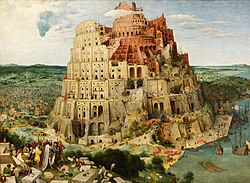| Tower of Babel | |
|---|---|
מִגְדַּל בָּבֶל | |
 The Tower of Babel by Pieter Bruegel the Elder (1563) | |
| General information | |
| Type | Tower |
| Location | Babylon, Iraq |
| Height | See § Height |
The Tower of Babel[a] is an origin myth and parable in the Book of Genesis meant to explain the existence of different languages and cultures.[1][2][3][4][5]
According to the story, a united human race speaking a single language migrates to Shinar (Lower Mesopotamia),[b] where they agree to build a great city with a tower that would reach the sky. Yahweh, observing these efforts and remarking on humanity's power in unity, confounds their speech so that they can no longer understand each other and scatters them around the world, leaving the city unfinished.
Some modern scholars have associated the Tower of Babel with known historical structures and accounts, particularly from ancient Mesopotamia. The most widely attributed inspiration is Etemenanki, a ziggurat dedicated to the god Marduk in Babylon,[6] which in Hebrew was called Babel.[7] A similar story is also found in the ancient Sumerian legend, Enmerkar and the Lord of Aratta, which describes events and locations in southern Mesopotamia.[8]
Cite error: There are <ref group=lower-alpha> tags or {{efn}} templates on this page, but the references will not show without a {{reflist|group=lower-alpha}} template or {{notelist}} template (see the help page).
- ^ 11:1–9
- ^ Metzger, Bruce Manning; Coogan, Michael D. (2004). The Oxford Guide To People And Places of the Bible. Oxford University Press. p. 28. ISBN 978-0-195-17610-0. Retrieved 22 December 2012.
- ^ Levenson, Jon D. (2004). "Genesis: Introduction and Annotations". In Berlin, Adele; Brettler, Marc Zvi (eds.). The Jewish Study Bible. Oxford University Press. p. 29. ISBN 978-0-195-29751-5.
- ^ Graves, Robert; Patai, Raphael (1986). Hebrew Myths: The Book of Genesis. Random House. p. 315. ISBN 978-0-795-33715-4.
- ^ Schwartz, Howard; Loebel-Fried, Caren; Ginsburg, Elliot K. (2007). Tree of Souls: The Mythology of Judaism. Oxford University Press. p. 704. ISBN 978-0-195-35870-4.
- ^ "Tower of Babel | Story, Summary, Meaning, & Facts | Britannica". www.britannica.com. Retrieved 4 September 2024.
- ^ "Tower of Babel | Story, Summary, Meaning, & Facts | Britannica". www.britannica.com. Retrieved 5 September 2024.
- ^ Kramer, Samuel Noah (1968). "The 'Babel of Tongues': A Sumerian Version". Journal of the American Oriental Society. Vol. 88, no. 1. pp. 108–111.